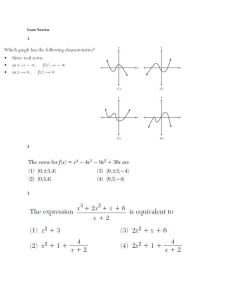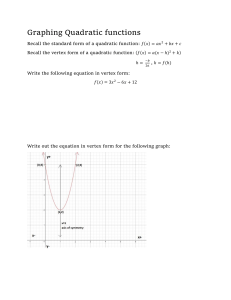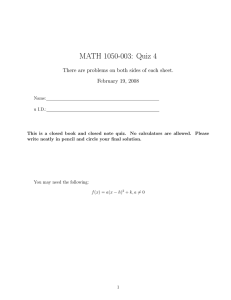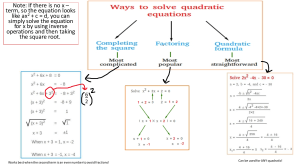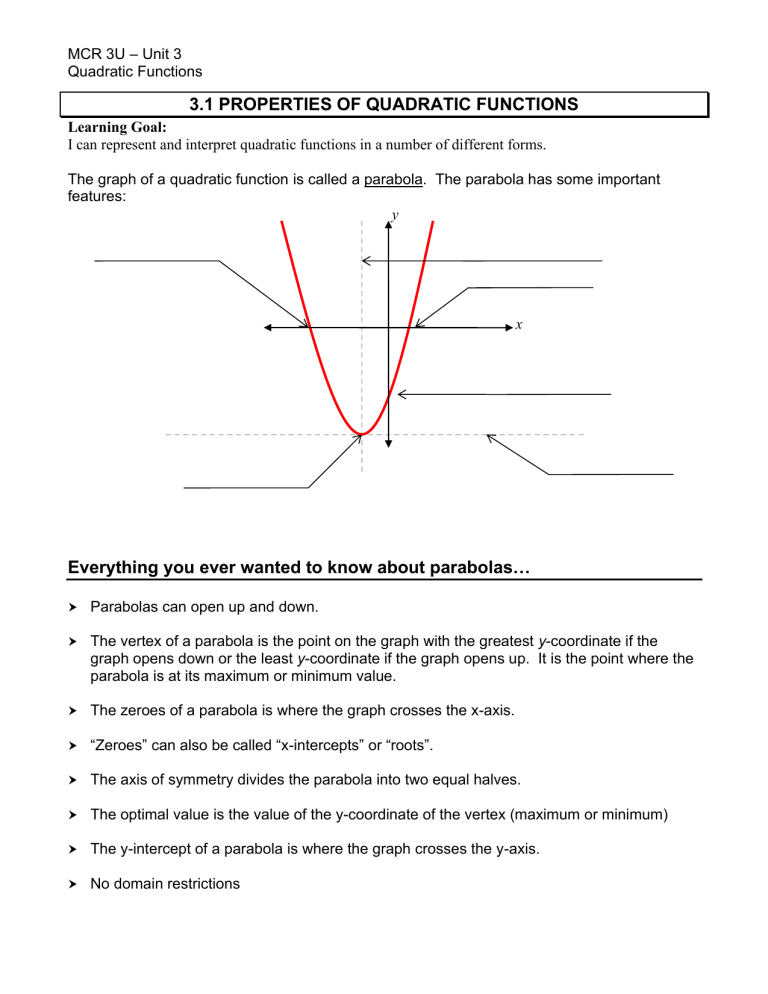
MCR 3U – Unit 3 Quadratic Functions 3.1 PROPERTIES OF QUADRATIC FUNCTIONS Learning Goal: I can represent and interpret quadratic functions in a number of different forms. The graph of a quadratic function is called a parabola. The parabola has some important features: y x Everything you ever wanted to know about parabolas… Parabolas can open up and down. The vertex of a parabola is the point on the graph with the greatest y-coordinate if the graph opens down or the least y-coordinate if the graph opens up. It is the point where the parabola is at its maximum or minimum value. The zeroes of a parabola is where the graph crosses the x-axis. “Zeroes” can also be called “x-intercepts” or “roots”. The axis of symmetry divides the parabola into two equal halves. The optimal value is the value of the y-coordinate of the vertex (maximum or minimum) The y-intercept of a parabola is where the graph crosses the y-axis. No domain restrictions MCR 3U – Unit 3 Quadratic Functions ALGEBRAIC FORMS OF A QUADRATIC STANDARD FORM f(x) = ax 2 + bx + c , a 0 FACTORED FORM f(x) = a(x − r)(x − s) , a 0 Examples For the following quadratic functions, fill in the table which follows: Function direction of opening vertex axis of symmetry zeroes y-intercept domain range f(x) = 2(x − 1) 2 − 5 VERTEX FORM f(x) = a(x - h) 2 + k , a 0 MCR 3U – Unit 3 Quadratic Functions Graphing a Quadratic Function from factored form. Graph f(x) = -(5x + 4)(5x + 11) 1. Use the zeroes to find the x value of the vertex. 2. Use the x value of the vertex to find the y value of the vertex. 3. Graph the function. MCR 3U – Unit 3 Quadratic Functions Review - COMPLETING THE SQUARE Recall: • To transform a quadratic equation from standard form to vertex form, we must complete the square. Step 1: Factor out the coefficient in front of x from the first 2 terms. Step 2: Take half of the coefficient of the ‘x’ term and square it. Add and subtract this value inside the brackets. Step 3: The negative number must come out of the bracket by multiplying it with the coefficient in front of the bracket. Step 4: Now you have a perfect square trinomial to factor. Step 5: Collect like terms and you’re done. Example 1 Write f(x) = 2x 2 + 12x − 3 in vertex form by completing the square. MCR 3U – Unit 3 Quadratic Functions Example 2 Write f(x) = -3x 2 + 15x − 11 in vertex form by completing the square. State the coordinates of the vertex. Example 3 Write f(x) = 5x2 + 3x + 1 into vertex form by completing the square. State the coordinates of the vertex. MCR 3U – Unit 3 Quadratic Functions 3.2 MAXIMUM AND MINIMUM VALUES Learning Goal: I can use a variety of strategies to determine the maximum or minimum value of a quadratic function. RECALL: • Standard form f(x) = ax 2 + bx + c → __________________________________________ • Factored form f(x) = a(x − r)(x − s) → __________________________________________ • Vertex form f(x) = a(x − h) 2 + k → _____________________________________________ • if a > 0, parabola opens __________ and has a __________________ value at the vertex • if a < 0, parabola opens ___________ and has a _________________ value at the vertex How do we change the equation from standard form to vertex form? Example 1 Without changing the form of the equation, find the coordinates of the vertex for the graph of f(x) = 2(x − 3)(x − 8) . Example 2 Without completing the square, find the coordinates of the vertex for the function f(x) = 2x 2 − 6x and state whether the function has a maximum or minimum value. MCR 3U – Unit 3 Quadratic Functions MAXIMIZING PROFITS • demand function p(x) → relation between _______________________, p, and the _____________________________, x. • revenue function R(x) → x demand function • cost function C(x) → relation between the ___________________________________, C, and the ____________________________ , x. • profit function P(x) → P(x) = R(x) – C(x) Example 3 a) Determine the revenue function for the demand function, p(x) = − x + 7 , where x is the number of items sold in thousands and p(x) is the price of each item. b) Determine the maximum revenue for the above function. Example 4 a) Determine the profit function for the revenue function, R(x) = − x 2 + 24x , and the cost function, 𝐶(𝑥) = 12𝑥 − 28. b) Determine the value of x that maximizes profit for the above function. MCR 3U – Unit 3 Quadratic Functions 3.5 SOLVING QUADRATIC EQUATIONS Learning Goal: I can solve problems involving quadratic functions by selecting the most appropriate method. To solve a quadratic equation means to find the ___________ • “____________” and “__________________” → refer to all values that make an equation ______________ STEPS FOR DETERMINING THE ROOTS OF A QUADRATIC RELATION ALGEBRAICALLY: 1. Expand and _____________ if needed. 2. Bring all the terms to ONE side of the equation so that it is in _______________________ form. 3. Make sure the other side of the equation is EQUAL to ______. 4. Try to __________________ the expression on one side. If you CAN factor: • Set the brackets equal to ____ and solve for ____. These values will be your roots. 5. If you CANNOT factor, use the _____________________ ____________________ to find the roots: x= − b b 2 − 4ac 2a Any solutions of an equation that does not work in the context of a problem is said to be an inadmissible solution. ______________________________________________________________________ Example 1 Anthony owns a business that sells parts for electronic game systems. The profit function for his business can be modeled by the equation P(x) = −0.5x2 + 8x − 24 , where x is the quantity sold, in thousands, and P(x) is the profit in thousands of dollars. Determine the number of parts Anthony must sell to break even. MCR 3U – Unit 3 Quadratic Functions Example 2 A water balloon is catapulted into the air from the top of a building. The height, h(t), in metres, of the balloon after t seconds is h(t) = −5t 2 + 30t +10 . a) What are the domain and range of this function? b) When will the balloon reach a height of 30 m? MCR 3U – Unit 3 Quadratic Functions 3.6 The Zeros of a Quadratic Functions Learning Goal: I can use a number of strategies to determine the number of zeros. The zeros of a quadratic function are x-intercepts of the function, which is where the parabola touches the x-axis. The zeros occur when _________________. PART A: GRAPHICALLY • Look at the graph and find the number of times the graph crosses or touches the x-axis PART B: ALGEBRAICALLY 1. Factored Form 𝑓(𝑥) = 𝑎(𝑥 − 𝑟)(𝑥 − 𝑠) has _________________ at 𝑥 = 𝑟 and 𝑥 = 𝑠. 𝑓(𝑥) = 𝑎(𝑥 − 𝑟)2 has _____________ at 𝑥 = 𝑟. 2. Vertex Form - 𝑓(𝑥) = 𝑎(𝑥 − ℎ)2 + 𝑘 • If 𝑎 and 𝑘 have _________________signs, then there are _______________ (parabola goes through the 𝑥-axis) • If ____________ then there is ______________ (vertex lies on the 𝑥-axis) • If 𝑎 and 𝑘 have the _____________ signs, then there are ______________ (parabola is above or below the 𝑥-axis) 3. Standard Form • To find the zeros, you would need to solve for 𝑓(𝑥) = 0 using the quadratic formula: 𝑥= −𝑏 ± √𝑏 2 − 4𝑎𝑐 2𝑎 • The expression ______________is called the ________________________. It tells the number of zeros for a quadratic function. • • • If 𝑏 2 − 4𝑎𝑐 __________, there are two zeros. If 𝑏 2 − 4𝑎𝑐 __________, there is one zero. If 𝑏 2 − 4𝑎𝑐 __________, there are no zeros. MCR 3U – Unit 3 Quadratic Functions Example 1 a) 𝑓(𝑥) = 3(𝑥 − 4)(𝑥 + 1) b) 𝑓(𝑥) = (𝑥 − 2)2 + 2 Example 2 For what value(s) of 𝒌 does the equation 𝑓(𝑥) = 3𝑥 2 + 4𝑥 + 𝑘 have no zeros? Example 3 A construction worker repairing a window tosses a tool to his partner across the street. The height of the tool above ground is modeled by the quadratic function ℎ(𝑡) = −5𝑡 2 + 20𝑡 + 25 where ℎ(𝑡) is the height in metres and 𝑡 is the time in seconds after the toss. a. How high above the ground is the window? b. If his partner misses the tool, when will it hit the ground? c. Determine the domain and range of the function in this situation. MCR 3U – Unit 3 Quadratic Functions 3.7 FAMILIES OF QUADRATIC EQUATIONS Learning Goal: I can investigate different families of a quadratic functions to see how they relate. INVESTIGATION 1. Graph each of the functions below on desmos. Sketch the graphs on the right. GROUP 1 f(x) = x 2 − 3x − 10 g(x) = −2x 2 + 6x + 20 h(x) = 4x 2 − 12x − 40 k(x) = −0.5x 2 + 1.5x + 5 2. How are the graphs the same? How are they different? 3. Write each of the functions in Group 1 in factored form. What do you notice? 4. Clear all functions, and then graph each of the functions for Group 2 on desmos. Sketch the graphs. GROUP 2 m(x) = −2x 2 + 4x + 1 n(x) = 0.5x 2 - 1x + 3.5 p(x) = -6x 2 + 12x - 3 q(x) = 10x 2 - 20x + 13 5. How are the graphs the same? How are they different? 6. Write each of the functions in Group 2 in vertex form. What do you notice? 7. Clear all functions, and then graph each of the functions in Group 3 on desmos. Sketch the graphs GROUP 3 r(x) = −3x 2 + 5x - 2 s(x) = 2x 2 + x - 2 t(x) = 7x 2 - 2x - 2 u(x) = -4x 2 - 4x - 2 8. What do these functions have in common? MCR 3U – Unit 3 Quadratic Functions SUMMARY 1. Vertex Form f(x) = a(x – h)2 + k Varying the value of a creates a family of parabolas with the same vertex and axis of symmetry 2. Factored Form f(x) = a(x – r)(x – s) Varying the value of a creates a family of parabolas with the same x-intercepts and axis of symmetry 3. Standard Form f(x) = ax2 + bx + c Varying the values of a and b creates a family of parabolas with the same y-intercept. Example 1 Given the function f(x) = –3(x + 2)2 – 1, determine another quadratic function with the same vertex. Example 2 Determine the equation of the quadratic function that passes through (–3, 20) if its zeros are 2 and –1. MCR 3U – Unit 3 Quadratic Functions 3.8 Linear-Quadratic Systems Learning Goal: I can solve problems involving the intersection of a linear and quadratic function, algebraically. Recall: To find the solution between two linear relations mean to find the __________ ______ _________________________ • To find the solution algebraically, we used ______________________ or _____________________ • There can only be _____, ______ or __________________ point(s) of intersection between two linear relations. A LINEAR FUNCTION and a QUADRATIC FUNCTION can intersect at: STEPS TO DETERMINE THE POINT(S) OF INTERSECTION ALGEBRAICALLY: 1. Use ______________________ to replace 𝑓(𝑥) in the quadratic function with the expression for 𝑔(𝑥) from the linear function. a. This means that we set both functions _____________ to each other. 2. Bring all terms to ________ side of the equation, in ___________________ form, setting the other side equal to ______. 3. Solve for 𝑥 by: a. _______________________ b. Using the _______________________ ____________________ 4. This results in a quadratic equation whose solutions correspond are the ____-COORDINATES of the points of intersection. 5. Once we have these values, we can substitute them into __________ equation in order to find the corresponding ____-coordinate. MCR 3U – Unit 3 Quadratic Functions Example 1 Determine the point(s) of intersection algebraically: 𝑓(𝑥) = – 𝑥 2 + 6𝑥 – 5 and 𝑔(𝑥) = – 4𝑥 + 19 STEPS TO DETERMINE THE NUMBER OF POINTS OF INTERSECTION: 1. ___________________ the two equations, and bring all terms to one side of the equation, so it appears to be in standard form (so you can easily see the “a”, “b”, and “c” values). 2. Calculate the _________________________. a. If ____________, there are 2 real roots. b. If ____________, there is 1 real root. c. If ____________, there are 0 real roots 3. The number of roots represent the NUMBER Of _______________________________ between the two functions. MCR 3U – Unit 3 Quadratic Functions Example 2 Determine the number of points of intersection of the quadratic and linear functions 𝑓(𝑥) = 3𝑥 2 + 12𝑥 + 14 and 𝑔(𝑥) = 2𝑥 − 8. Example 3 Justin is skeet shooting. The height of the skeet is modeled by the function ℎ(𝑡) = −5𝑡 2 + 32𝑡 + 2, where ℎ(𝑡) is the height in metres 𝑡 seconds after the skeet is released. The path of Justin’s bullet is modeled by the function 𝑔(𝑡) = 31.5𝑡 + 1, with the same units. a. How long will it take for the bullet to hit the skeet? b. How high off the ground will the skeet be when it is hit? MCR 3U – Unit 3 Quadratic Functions 3.3 INVERSE OF A QUADRATIC FUNCTION Learning Goal: I can determine the inverse of a quadratic function. Recall: • To find the inverse of a function, you need to __________________________________ Example 1 Consider the graph of f(x) = x2 below. a) Graph the inverse function using a different colour for each branch. b) State the domain and range of f(x) = x2 and the inverse relation. c) Determine whether the inverse of f(x) = x2 is also a function. d) What restrictions could you place on the domain of the original function so that the inverse could be a function? e) Determine the equation of the inverse. The inverse of a quadratic function can be a function if the domain of the original function is restricted. The vertex of the parabola points to the beginning of a domain and range. To determine the vertex of a parabola, complete the square. MCR 3U – Unit 3 Quadratic Functions Example 2 For f(x) = 2(x + 3)2 − 4 , a) Determine the equation of the inverse. b) Restrict the domain of the original function so that its inverse is a function. Example 3 For f(x) = 3x 2 + 6x + 5 , a) Restrict the domain so the f −1 is a function (need the vertex). b) Find the equation of f −1 (x) using that restriction.
